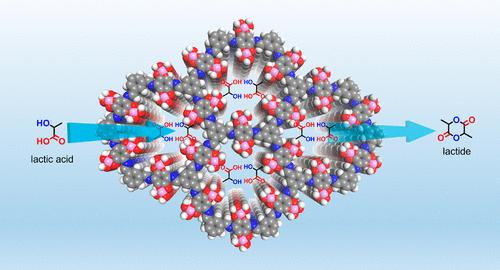基于磷酸的共价有机框架的微环境效应催化作用
IF 11.3
1区 化学
Q1 CHEMISTRY, PHYSICAL
引用次数: 0
摘要
从酶催化中汲取灵感,我们设计了一种基于磷酸的共价有机框架 (PA-COF),用于高效合成光学纯内酯。PA-COF 催化剂的特点是在以磷酸为催化活性位点的定义明确的多孔通道内精确设计微环境。PA-COF 与酶催化类似,其产物选择性受蛋白质口袋的控制,而 PA-COF 则因其高度有序的通道和可调整的结构而提供了精确的微环境。通道中的磷酸作为催化活性位点,在将乳酸单体直接转化为环状二聚体乳内酯的过程中发挥了关键作用。该工艺有效地避免了低聚作用,实现了约 95% 的高产率。这种方法与传统的两步法有很大不同。它避免了使用金属催化剂和高温(∼200 °C)反应条件,从而避免了金属残留和消旋化。这种微环境效应催化策略为合成内酯提供了一条新途径,并可推广到其他有用的缩合反应中。本文章由计算机程序翻译,如有差异,请以英文原文为准。

Microenvironment Effect Catalysis with Phosphoric Acid-Based Covalent Organic Frameworks
Drawing inspiration from enzymatic catalysis, a phosphoric acid-based covalent organic framework (PA-COF) was engineered for the efficient synthesis of optically pure lactide. PA-COF catalyst features precisely engineered microenvironments within well-defined porous channels decorated with phosphoric acid as the catalytically active sites. Much like enzymatic catalysis, where product selectivity is governed by the protein pocket, PA-COF provides precise microenvironments due to its highly ordered channels and adjustable structures. The phosphoric acids in the channels as catalytically active sites play key roles in directly converting lactic acid monomers into the cyclic dimer lactide. The process effectively avoided oligomerization, achieving an excellent yield of approximately 95%. This approach significantly differs from the traditional two-step strategy. It avoids the use of metal catalysts and high-temperature (∼200 °C) reaction conditions, thus avoiding metal residues and racemization. This microenvironment effect catalysis strategy provides a new pathway for the synthesis of lactide and may be extended to other useful condensation reactions.
求助全文
通过发布文献求助,成功后即可免费获取论文全文。
去求助
来源期刊

ACS Catalysis
CHEMISTRY, PHYSICAL-
CiteScore
20.80
自引率
6.20%
发文量
1253
审稿时长
1.5 months
期刊介绍:
ACS Catalysis is an esteemed journal that publishes original research in the fields of heterogeneous catalysis, molecular catalysis, and biocatalysis. It offers broad coverage across diverse areas such as life sciences, organometallics and synthesis, photochemistry and electrochemistry, drug discovery and synthesis, materials science, environmental protection, polymer discovery and synthesis, and energy and fuels.
The scope of the journal is to showcase innovative work in various aspects of catalysis. This includes new reactions and novel synthetic approaches utilizing known catalysts, the discovery or modification of new catalysts, elucidation of catalytic mechanisms through cutting-edge investigations, practical enhancements of existing processes, as well as conceptual advances in the field. Contributions to ACS Catalysis can encompass both experimental and theoretical research focused on catalytic molecules, macromolecules, and materials that exhibit catalytic turnover.
 求助内容:
求助内容: 应助结果提醒方式:
应助结果提醒方式:


